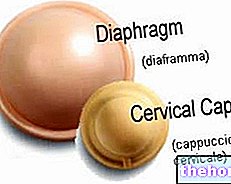Choice of contraceptive method
Each couple can live their sexuality freely, choosing the contraceptive method that best suits their needs and requirements. The protagonists of a relationship may also decide not to use any contraceptive method. What is fundamental is that everyone takes responsibility for their actions, ready to face any possible unknown that could result from a potentially risky sexual behavior.
The market offers a wide range of contraceptive methods, many of which are extremely practical to use and quite safe in terms of protection from unexpected pregnancy and STDs. Each contraceptive method has disadvantages and advantages; therefore, it is up to both partners of the couple to choose the one that best suits their needs.
We focus on mechanical or barrier methods of contraception. What are they? What advantages and disadvantages do they have? Are they effective against STDs and unwanted pregnancies?
No contraceptive method guarantees full coverage from sexually transmitted diseases and unwanted pregnancies. The only solution to have a total guarantee, free from risks and side effects, is total abstinence from any sexual contact (both vaginal, oral or anal).
Mechanical or "barrier" contraceptives
Barrier contraceptive methods are birth control devices that prevent pregnancy by denying direct contact between sperm and egg cell, while protecting both partners from sexually transmitted diseases.
The index of protection from unwanted pregnancy and venereal disease changes according to the contraceptive method considered.
The condom (also called condom or condom) is the title of the chapter on "barrier" methods of contraception.
In addition to the condom, there are other mechanical methods of contraception:
- Diaphragm to always be combined with spermicides
- Cervical cap (little used)
- Female condom
- Cervical sponges (not available in Italy)
- Occlusive pessary (ancient contraceptive practice, currently not used)
General characteristics
The general characteristics, advantages and disadvantages of each barrier contraceptive method are described in the table. Furthermore, a percentage value is reported which expresses the theoretical protection guaranteed by the contraceptive from unwanted pregnancies.
Condom
- The condom is a thin elastic sheath that is made to adhere to the penis in erection. The aim is to collect the ejaculate and prevent it from entering the vagina during sexual intercourse.
- The condom is the only contraceptive method that offers excellent (but not absolute) protection from venereal diseases
- It offers excellent protection from unwanted pregnancy and STDs
- Easy availability
- Relatively low cost
- It does not require a medical prescription
- Long shelf life (about 2 years). The condom however requires to be stored in a dry place, away from heat
- Indicated for casual sexual relations
- Can be used in combination with spermicides compatible with the condom material (e.g. nonoxynol-9)
- It adapts perfectly to the size of the penis
- It cannot be used more than once
- When not used correctly, the risk of contraceptive failure increases (condom breakage)
- Latex condoms should not be used by individuals who are allergic to them. Alternatively, prefer condoms made with synthetic materials (e.g. polyurethane)
- Combined with oil-based lubricants, condoms can break or tear
- Possible (albeit modest) decrease in male sexual pleasure
- Used correctly, the "common" (latex) condom offers "excellent protection from unwanted pregnancies and venereal diseases (85-99.8%)
- Animal skin condoms offer no protection from STDs
Diaphragm
- Small soft rubber dome mounted on a malleable and foldable metal ring, which the woman inserts near the neck of the uterus (transvaginally) a few moments before sexual intercourse
- Must "be used together with spermicides to reduce the risk coefficient (ie the failure of the contraceptive method)
- It is a mechanical contraceptive method, which does not interfere with the normal functions of the reproductive system
- The diaphragm does not interfere with the performance of sexual intercourse, since its presence is not perceived by either the man or the woman
- Contraceptive method now in disuse because it is not completely reliable.
- Rather difficult to insert (especially for very young girls)
- Remove the diaphragm from the vagina only 6-8 hours after full intercourse, to allow the spermicide to act.
- Do not hold the diaphragm in the vagina beyond 24 consecutive hours
- The contraceptive method is not suitable for women with vaginal malformations or allergic to spermicides
- This contraceptive method cannot be used in case of vaginal inflammation
- The first applications of the diaphragm can be quite complicated
- The use of this contraceptive method requires a certain programming of the sexual act
- Little or no protection from sexually transmitted diseases
- Poor. The failure rate is estimated at around 20% (Pearl index equal to 2-3)
- Protection from unwanted pregnancy is affected by the correct application of the contraceptive method
Cervical hood
- It is a barrier method of contraception, consisting of a bell-shaped rubber device (latex or silicone), to be inserted inside the vagina in close contact with the cervix. Very similar to the diaphragm, it differs from the latter. due to its smaller size and the ability to adhere closely to the tench snout
- The cervical cap is inserted into the vagina before intercourse. She must remain in this position for at least 6-8 hours after intercourse
- It fits snugly to the portion of the cervix that protrudes into the vagina
- For further protection from unwanted pregnancy, it is advisable to fill the cervical cap with spermicide. In doing so, the spermicide damages or kills any sperm that pass the narrow gap between the cap and the neck of the uterus.
- A variant of the classic cervical cap is the so-called SCUDO DI LEA, which does not require dimensional adjustment, since it remains in its correct position thanks to a "sucking" mechanism.
- Indicated exclusively for young women who have never given birth vaginally, for which it offers superior protection to the diaphragm.
- Before using a cervical cap, the woman must undergo a gynecological examination to determine the size of the device that best suits her genital anatomy
- The contraceptive method is not suitable for women with vaginas that are too deep: in this case, the woman may have difficulty in fitting the cervical cap correctly
- Fair coverage from unwanted pregnancies, equal to 80-98% for nulliparous women (failure rate: 2-20%).
- The contraceptive efficacy of the method decreases to 80-95% in women who have given birth. Recall that vaginal birth determines important changes in the cervix and vaginal canal, especially in terms of shape and size.
Female condom
- Barrier contraceptive method consisting of two flexible rings, joined by a thin and soft sheath of polyurethane, synthetic nitrile or latex, about 17 cm long (medium size)
- The inner ring (hermetically closed) must be pushed deeply into the vagina: this will naturally position itself behind the pubic bone.
- The outer ring - at the opposite end - remains open outside the vagina, partially covering the external genitals. In this way, the man can introduce the erect penis into the vagina from this opening.
- The female condom protects against unwanted pregnancy by preventing contact between sperm and egg cell
- It is not necessary to take out the female condom immediately after intercourse
- This barrier method of contraception guarantees a fair / valid coverage from unwanted pregnancies and venereal diseases
- It can be inserted into the vagina a few hours before intercourse
- There are different sizes of the female condom; therefore, the woman can choose the variant that best suits the anatomy of the genitals
- It is possible to combine this barrier method of contraception with water-based and oil-based lubricants (except, in the latter case, for the female condom made of latex)
- Unlike the male condom, the female variant ensures greater sensitivity to the man during intercourse
- It does not require a prescription
- Relatively low cost (slightly higher than the male condom)
- Rather effective alternative for women who cannot take hormonal contraceptives
- It must be used only once
- Women who have given birth vaginally generally need larger sized female condoms than standard ones
- The female latex condom cannot be used in conjunction with oil-based lubricants
- Do not use the female latex condom if you have a latex allergy. In such circumstances, prefer that of nitrile
- During intercourse, the friction triggered by the contact between the condom and the skin causes a "buzz" or a "rustle" not always appreciated by the couple
- The lubricant with which the female condom is coated is sticky and can adhere to the skin of the fingers during insertion
- This contraceptive method requires a certain "exercise" for correct insertion
- Fair (79-95%)
Vaginal sponges
- Vaginal sponges are small, soft, rounded contraceptive devices, similar to sponges. They are made of a synthetic material (polyurethane) and soaked in spermicide.
After being wetted with water, the device - becoming soft and spongy - can be applied in the vagina just before intercourse. - They are little known methods of contraception in Italy, currently on sale in the USA
- Contraceptive sponges prevent unwanted pregnancy by combining the "barrier" method (covers the cervix) with "chemical" contraception (performed by spermicides)
- It does not require a prescription
- The sponge moistened with water adapts perfectly to the size and structure of the cervix
- Good alternative to the diaphragm
- It is possible to increase the contraceptive efficacy of the sponges by combining an additional contraceptive method (eg condom)
- The contraceptive device must be kept in the vagina for a period not exceeding 24-30 consecutive hours after intercourse.
- When held for more than 30 consecutive hours, the contraceptive sponge can cause severe side reactions (e.g. toxic shock syndrome)
- Before removing the contraceptive sponge, wait at least 6 hours from the last intercourse to allow the spermicide to act, thus ensuring further coverage from unwanted pregnancies.
- Do not use this contraceptive method in case of allergy or hypersensitivity to the spermicide used (nonoxinol 9)
- The extraction of the contraceptive sponge is not always immediate and simple
- The contraceptive method is not suitable for women with a retroverted uterus
- They have a modest contraceptive efficacy: vaginal sponges protect against unwanted pregnancy in 77-91% of cases (the failure rate ranges from 9 to 23%).
- It offers no protection from STDs
Other articles on "Mechanical Contraceptives - Barrier Methods"
- Contraceptives - Types of Contraceptives
- Hormonal contraceptives
- Contraceptives D "Urgency - Morning After Pill and Spiral
- Implantable contraceptives: IUD coil and sticks
- Chemical Contraceptives or Spermicides
- Natural Contraception









.jpg)


















